Individual Essay: Evaluating Change Agents in Organizational Settings
VerifiedAdded on 2021/05/31
|10
|2709
|81
Essay
AI Summary
This essay delves into the critical decision-making process organizations undertake when implementing change management strategies, specifically focusing on the selection of internal versus external change agents. It begins by establishing the fundamental concept of organizational change as a response to internal and external pressures, highlighting the necessity for agents to facilitate and lead these transitions. The essay then defines the roles and responsibilities of both internal and external change agents, outlining their respective strengths and weaknesses. Internal agents, familiar with organizational culture and processes, may lack specialized expertise or face resistance, whereas external agents bring objective perspectives and specialized knowledge but may require time to understand the organization's nuances. The essay presents real-world examples, such as General Motors and Singaporean SMEs, to illustrate the practical implications of choosing the right agent based on specific circumstances. The analysis further explores the various skills and qualities required for effective change leadership, including communication, conflict resolution, and emotional intelligence. Ultimately, the essay emphasizes that the optimal choice depends on the specific context, organizational needs, and desired outcomes of the change initiative, providing valuable insights for effective change management practices.
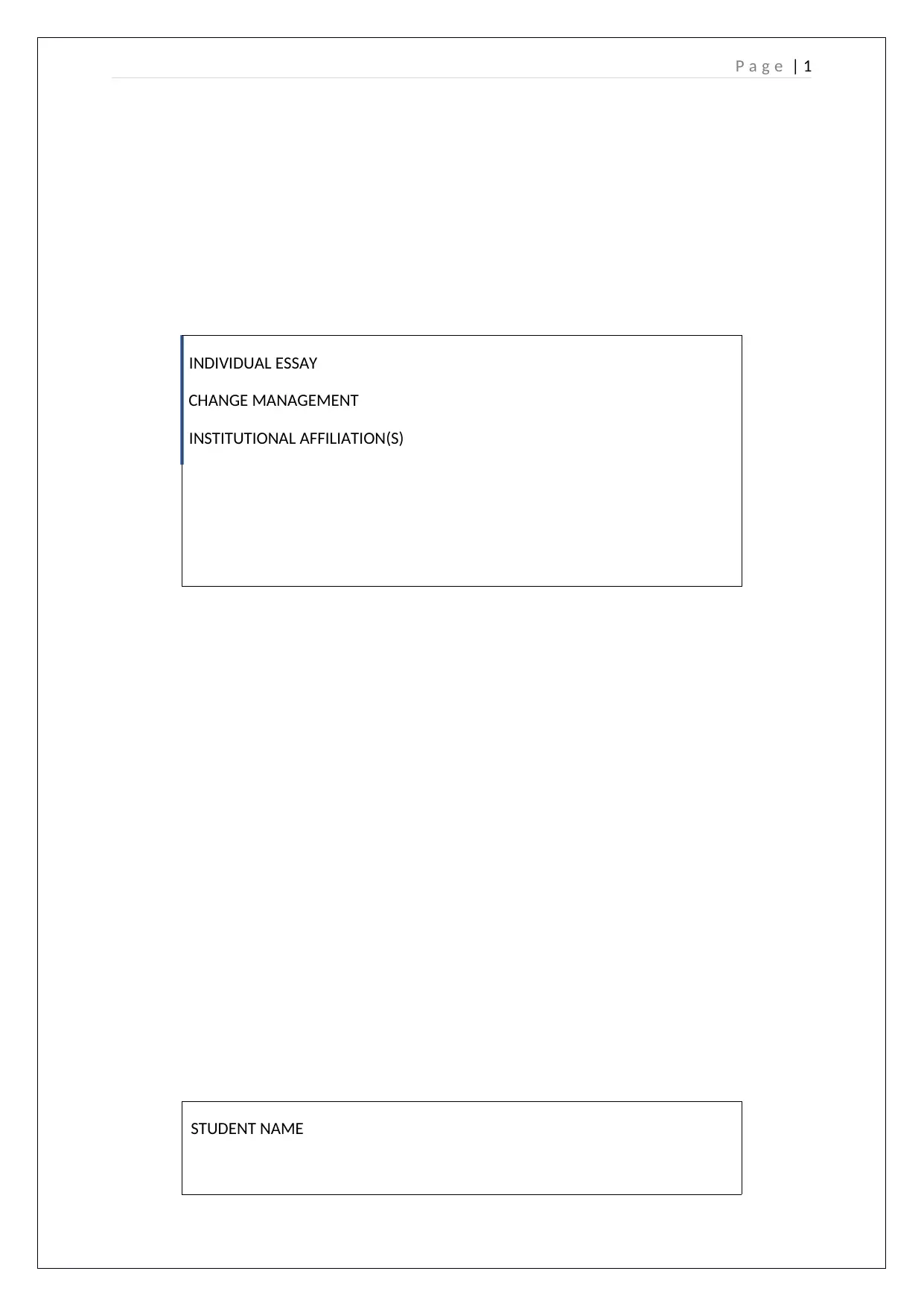
P a g e | 1
INDIVIDUAL ESSAY
CHANGE MANAGEMENT
INSTITUTIONAL AFFILIATION(S)
STUDENT NAME
INDIVIDUAL ESSAY
CHANGE MANAGEMENT
INSTITUTIONAL AFFILIATION(S)
STUDENT NAME
Paraphrase This Document
Need a fresh take? Get an instant paraphrase of this document with our AI Paraphraser
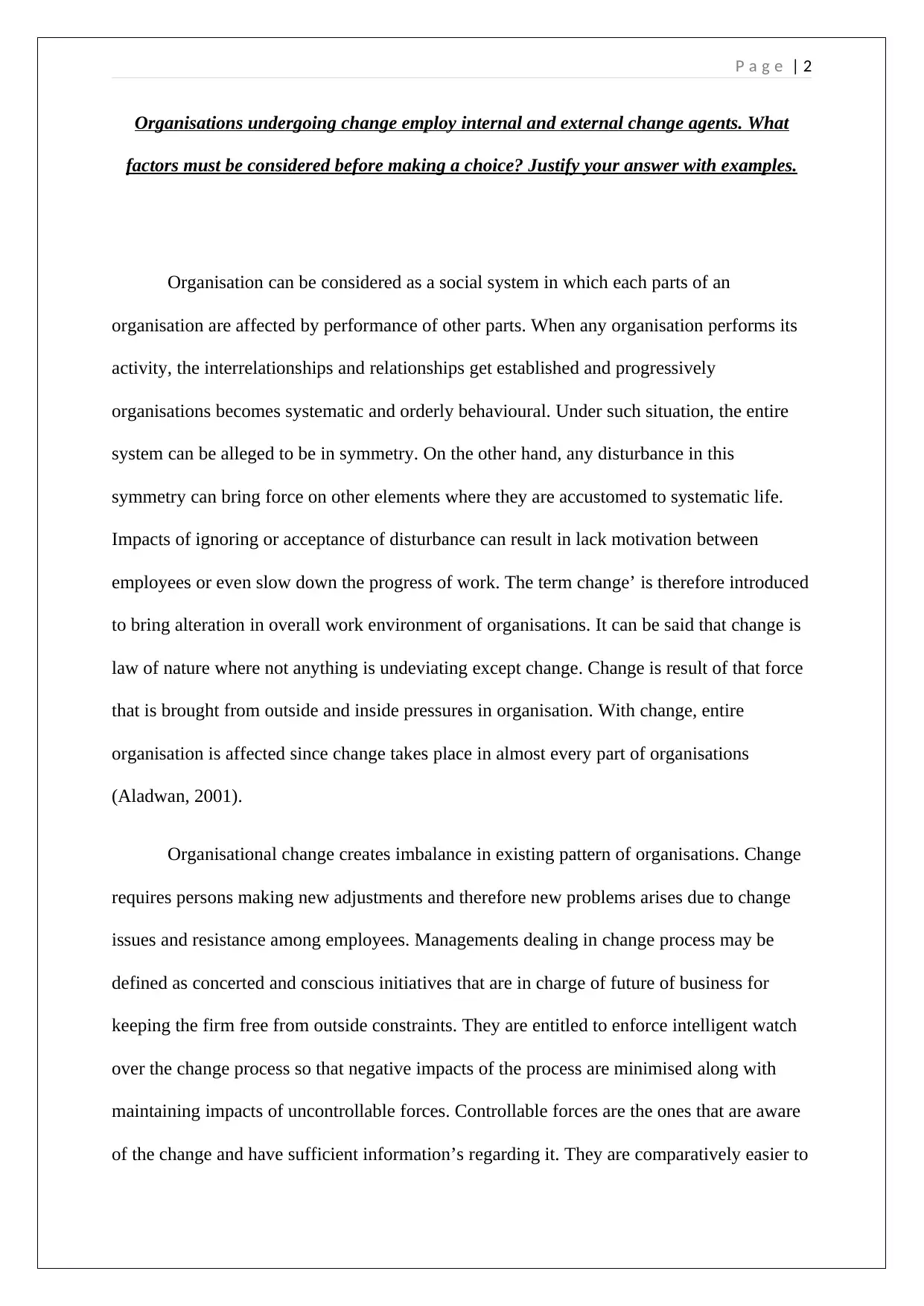
P a g e | 2
Organisations undergoing change employ internal and external change agents. What
factors must be considered before making a choice? Justify your answer with examples.
Organisation can be considered as a social system in which each parts of an
organisation are affected by performance of other parts. When any organisation performs its
activity, the interrelationships and relationships get established and progressively
organisations becomes systematic and orderly behavioural. Under such situation, the entire
system can be alleged to be in symmetry. On the other hand, any disturbance in this
symmetry can bring force on other elements where they are accustomed to systematic life.
Impacts of ignoring or acceptance of disturbance can result in lack motivation between
employees or even slow down the progress of work. The term change’ is therefore introduced
to bring alteration in overall work environment of organisations. It can be said that change is
law of nature where not anything is undeviating except change. Change is result of that force
that is brought from outside and inside pressures in organisation. With change, entire
organisation is affected since change takes place in almost every part of organisations
(Aladwan, 2001).
Organisational change creates imbalance in existing pattern of organisations. Change
requires persons making new adjustments and therefore new problems arises due to change
issues and resistance among employees. Managements dealing in change process may be
defined as concerted and conscious initiatives that are in charge of future of business for
keeping the firm free from outside constraints. They are entitled to enforce intelligent watch
over the change process so that negative impacts of the process are minimised along with
maintaining impacts of uncontrollable forces. Controllable forces are the ones that are aware
of the change and have sufficient information’s regarding it. They are comparatively easier to
Organisations undergoing change employ internal and external change agents. What
factors must be considered before making a choice? Justify your answer with examples.
Organisation can be considered as a social system in which each parts of an
organisation are affected by performance of other parts. When any organisation performs its
activity, the interrelationships and relationships get established and progressively
organisations becomes systematic and orderly behavioural. Under such situation, the entire
system can be alleged to be in symmetry. On the other hand, any disturbance in this
symmetry can bring force on other elements where they are accustomed to systematic life.
Impacts of ignoring or acceptance of disturbance can result in lack motivation between
employees or even slow down the progress of work. The term change’ is therefore introduced
to bring alteration in overall work environment of organisations. It can be said that change is
law of nature where not anything is undeviating except change. Change is result of that force
that is brought from outside and inside pressures in organisation. With change, entire
organisation is affected since change takes place in almost every part of organisations
(Aladwan, 2001).
Organisational change creates imbalance in existing pattern of organisations. Change
requires persons making new adjustments and therefore new problems arises due to change
issues and resistance among employees. Managements dealing in change process may be
defined as concerted and conscious initiatives that are in charge of future of business for
keeping the firm free from outside constraints. They are entitled to enforce intelligent watch
over the change process so that negative impacts of the process are minimised along with
maintaining impacts of uncontrollable forces. Controllable forces are the ones that are aware
of the change and have sufficient information’s regarding it. They are comparatively easier to
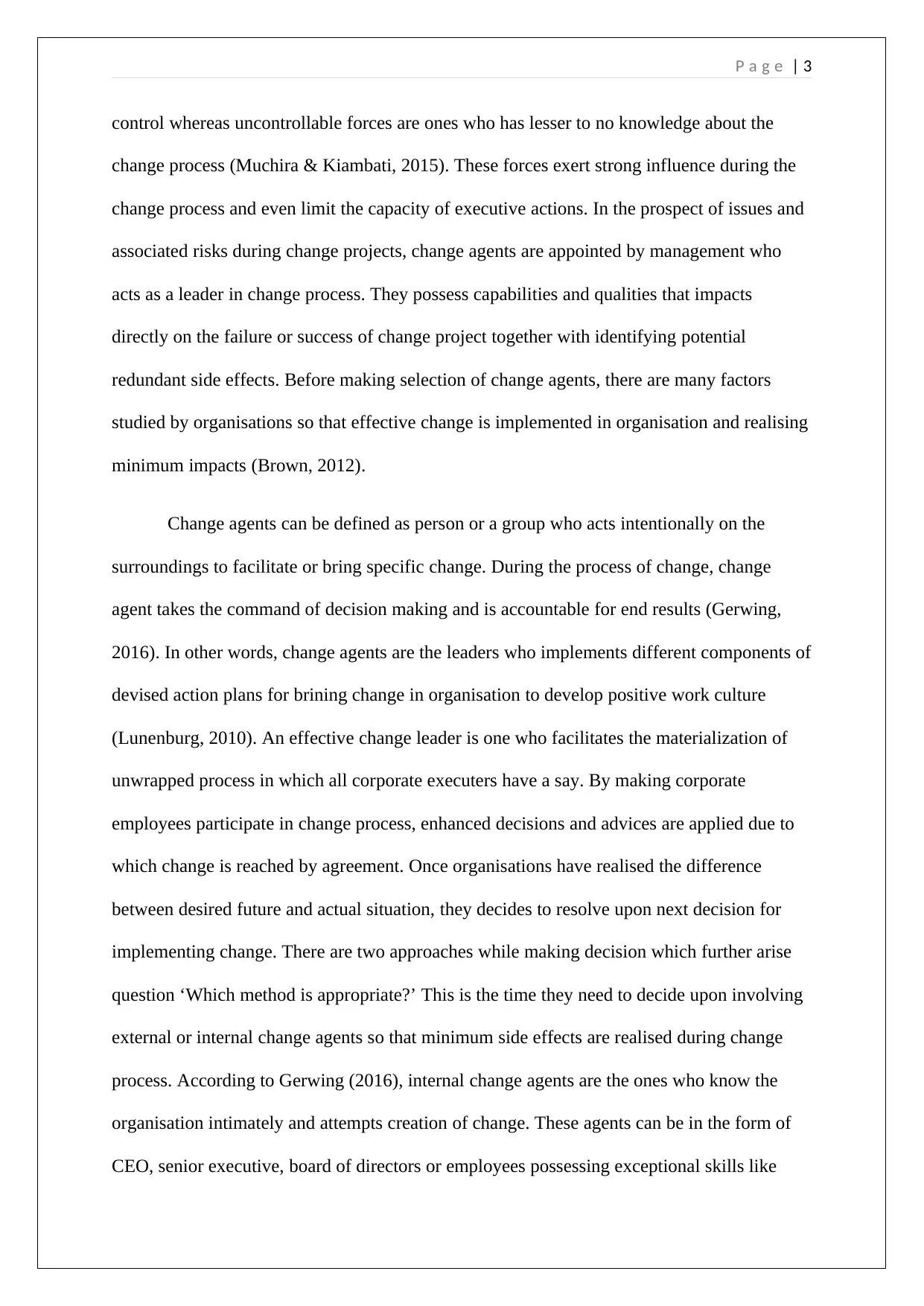
P a g e | 3
control whereas uncontrollable forces are ones who has lesser to no knowledge about the
change process (Muchira & Kiambati, 2015). These forces exert strong influence during the
change process and even limit the capacity of executive actions. In the prospect of issues and
associated risks during change projects, change agents are appointed by management who
acts as a leader in change process. They possess capabilities and qualities that impacts
directly on the failure or success of change project together with identifying potential
redundant side effects. Before making selection of change agents, there are many factors
studied by organisations so that effective change is implemented in organisation and realising
minimum impacts (Brown, 2012).
Change agents can be defined as person or a group who acts intentionally on the
surroundings to facilitate or bring specific change. During the process of change, change
agent takes the command of decision making and is accountable for end results (Gerwing,
2016). In other words, change agents are the leaders who implements different components of
devised action plans for brining change in organisation to develop positive work culture
(Lunenburg, 2010). An effective change leader is one who facilitates the materialization of
unwrapped process in which all corporate executers have a say. By making corporate
employees participate in change process, enhanced decisions and advices are applied due to
which change is reached by agreement. Once organisations have realised the difference
between desired future and actual situation, they decides to resolve upon next decision for
implementing change. There are two approaches while making decision which further arise
question ‘Which method is appropriate?’ This is the time they need to decide upon involving
external or internal change agents so that minimum side effects are realised during change
process. According to Gerwing (2016), internal change agents are the ones who know the
organisation intimately and attempts creation of change. These agents can be in the form of
CEO, senior executive, board of directors or employees possessing exceptional skills like
control whereas uncontrollable forces are ones who has lesser to no knowledge about the
change process (Muchira & Kiambati, 2015). These forces exert strong influence during the
change process and even limit the capacity of executive actions. In the prospect of issues and
associated risks during change projects, change agents are appointed by management who
acts as a leader in change process. They possess capabilities and qualities that impacts
directly on the failure or success of change project together with identifying potential
redundant side effects. Before making selection of change agents, there are many factors
studied by organisations so that effective change is implemented in organisation and realising
minimum impacts (Brown, 2012).
Change agents can be defined as person or a group who acts intentionally on the
surroundings to facilitate or bring specific change. During the process of change, change
agent takes the command of decision making and is accountable for end results (Gerwing,
2016). In other words, change agents are the leaders who implements different components of
devised action plans for brining change in organisation to develop positive work culture
(Lunenburg, 2010). An effective change leader is one who facilitates the materialization of
unwrapped process in which all corporate executers have a say. By making corporate
employees participate in change process, enhanced decisions and advices are applied due to
which change is reached by agreement. Once organisations have realised the difference
between desired future and actual situation, they decides to resolve upon next decision for
implementing change. There are two approaches while making decision which further arise
question ‘Which method is appropriate?’ This is the time they need to decide upon involving
external or internal change agents so that minimum side effects are realised during change
process. According to Gerwing (2016), internal change agents are the ones who know the
organisation intimately and attempts creation of change. These agents can be in the form of
CEO, senior executive, board of directors or employees possessing exceptional skills like
⊘ This is a preview!⊘
Do you want full access?
Subscribe today to unlock all pages.

Trusted by 1+ million students worldwide
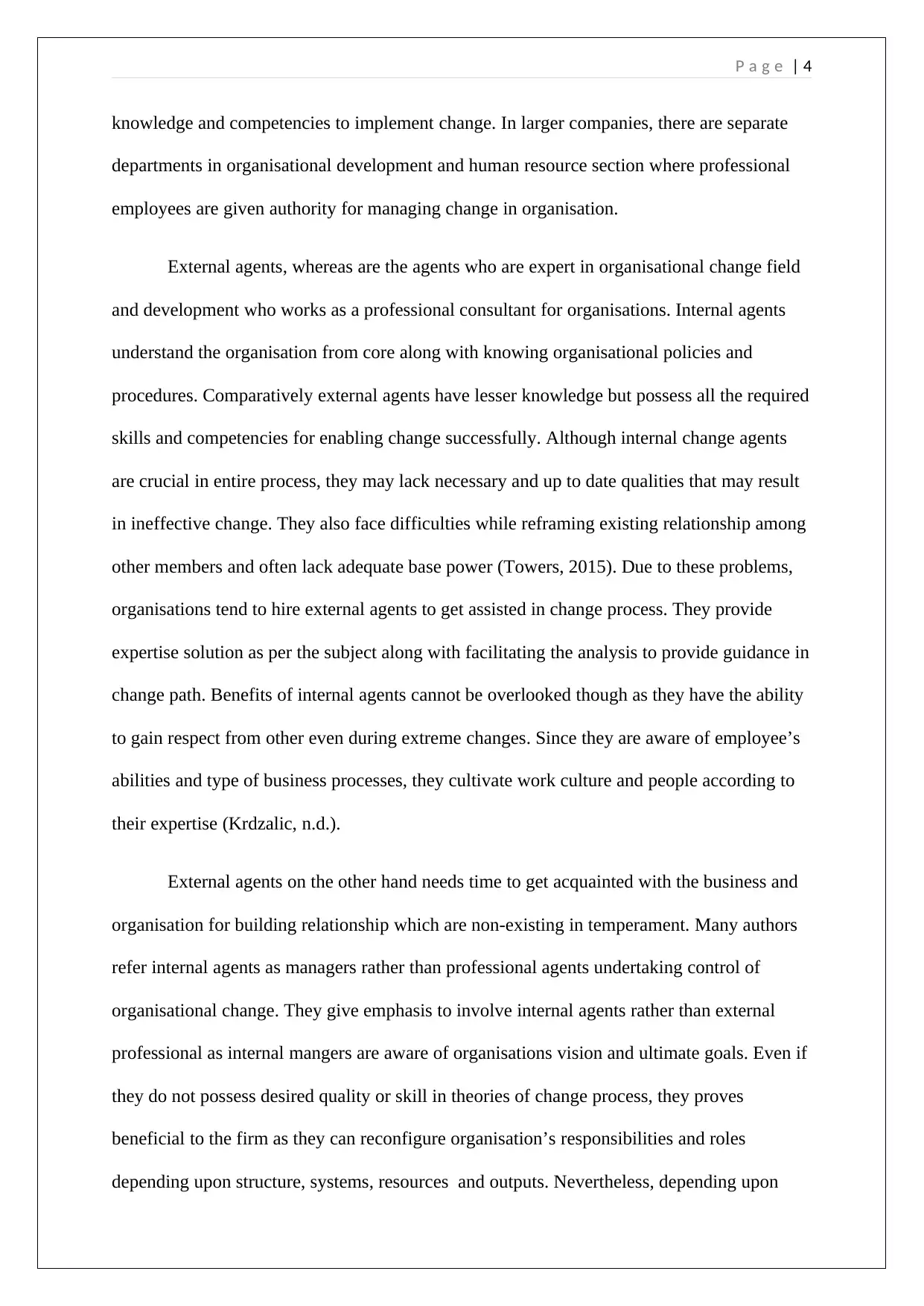
P a g e | 4
knowledge and competencies to implement change. In larger companies, there are separate
departments in organisational development and human resource section where professional
employees are given authority for managing change in organisation.
External agents, whereas are the agents who are expert in organisational change field
and development who works as a professional consultant for organisations. Internal agents
understand the organisation from core along with knowing organisational policies and
procedures. Comparatively external agents have lesser knowledge but possess all the required
skills and competencies for enabling change successfully. Although internal change agents
are crucial in entire process, they may lack necessary and up to date qualities that may result
in ineffective change. They also face difficulties while reframing existing relationship among
other members and often lack adequate base power (Towers, 2015). Due to these problems,
organisations tend to hire external agents to get assisted in change process. They provide
expertise solution as per the subject along with facilitating the analysis to provide guidance in
change path. Benefits of internal agents cannot be overlooked though as they have the ability
to gain respect from other even during extreme changes. Since they are aware of employee’s
abilities and type of business processes, they cultivate work culture and people according to
their expertise (Krdzalic, n.d.).
External agents on the other hand needs time to get acquainted with the business and
organisation for building relationship which are non-existing in temperament. Many authors
refer internal agents as managers rather than professional agents undertaking control of
organisational change. They give emphasis to involve internal agents rather than external
professional as internal mangers are aware of organisations vision and ultimate goals. Even if
they do not possess desired quality or skill in theories of change process, they proves
beneficial to the firm as they can reconfigure organisation’s responsibilities and roles
depending upon structure, systems, resources and outputs. Nevertheless, depending upon
knowledge and competencies to implement change. In larger companies, there are separate
departments in organisational development and human resource section where professional
employees are given authority for managing change in organisation.
External agents, whereas are the agents who are expert in organisational change field
and development who works as a professional consultant for organisations. Internal agents
understand the organisation from core along with knowing organisational policies and
procedures. Comparatively external agents have lesser knowledge but possess all the required
skills and competencies for enabling change successfully. Although internal change agents
are crucial in entire process, they may lack necessary and up to date qualities that may result
in ineffective change. They also face difficulties while reframing existing relationship among
other members and often lack adequate base power (Towers, 2015). Due to these problems,
organisations tend to hire external agents to get assisted in change process. They provide
expertise solution as per the subject along with facilitating the analysis to provide guidance in
change path. Benefits of internal agents cannot be overlooked though as they have the ability
to gain respect from other even during extreme changes. Since they are aware of employee’s
abilities and type of business processes, they cultivate work culture and people according to
their expertise (Krdzalic, n.d.).
External agents on the other hand needs time to get acquainted with the business and
organisation for building relationship which are non-existing in temperament. Many authors
refer internal agents as managers rather than professional agents undertaking control of
organisational change. They give emphasis to involve internal agents rather than external
professional as internal mangers are aware of organisations vision and ultimate goals. Even if
they do not possess desired quality or skill in theories of change process, they proves
beneficial to the firm as they can reconfigure organisation’s responsibilities and roles
depending upon structure, systems, resources and outputs. Nevertheless, depending upon
Paraphrase This Document
Need a fresh take? Get an instant paraphrase of this document with our AI Paraphraser
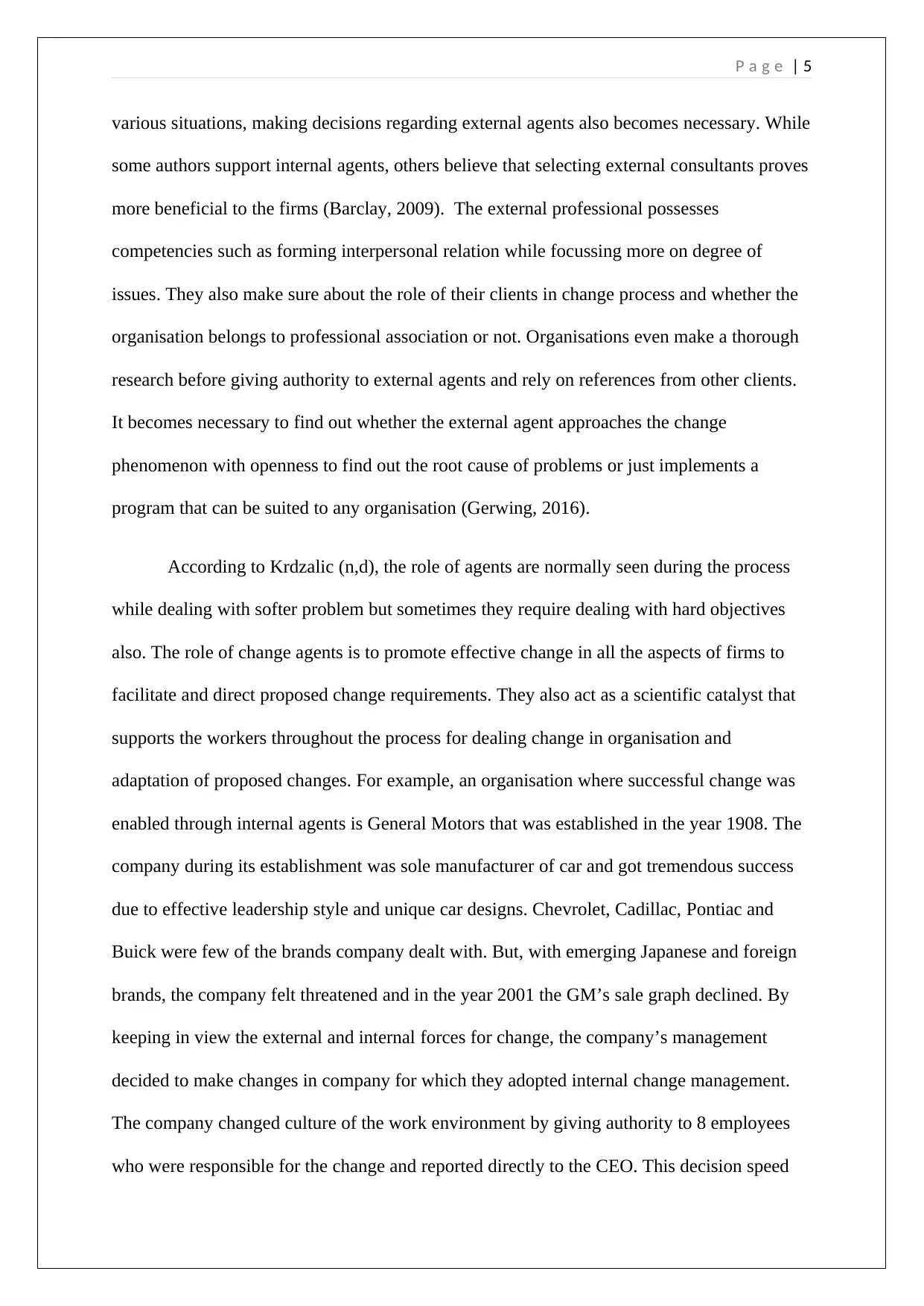
P a g e | 5
various situations, making decisions regarding external agents also becomes necessary. While
some authors support internal agents, others believe that selecting external consultants proves
more beneficial to the firms (Barclay, 2009). The external professional possesses
competencies such as forming interpersonal relation while focussing more on degree of
issues. They also make sure about the role of their clients in change process and whether the
organisation belongs to professional association or not. Organisations even make a thorough
research before giving authority to external agents and rely on references from other clients.
It becomes necessary to find out whether the external agent approaches the change
phenomenon with openness to find out the root cause of problems or just implements a
program that can be suited to any organisation (Gerwing, 2016).
According to Krdzalic (n,d), the role of agents are normally seen during the process
while dealing with softer problem but sometimes they require dealing with hard objectives
also. The role of change agents is to promote effective change in all the aspects of firms to
facilitate and direct proposed change requirements. They also act as a scientific catalyst that
supports the workers throughout the process for dealing change in organisation and
adaptation of proposed changes. For example, an organisation where successful change was
enabled through internal agents is General Motors that was established in the year 1908. The
company during its establishment was sole manufacturer of car and got tremendous success
due to effective leadership style and unique car designs. Chevrolet, Cadillac, Pontiac and
Buick were few of the brands company dealt with. But, with emerging Japanese and foreign
brands, the company felt threatened and in the year 2001 the GM’s sale graph declined. By
keeping in view the external and internal forces for change, the company’s management
decided to make changes in company for which they adopted internal change management.
The company changed culture of the work environment by giving authority to 8 employees
who were responsible for the change and reported directly to the CEO. This decision speed
various situations, making decisions regarding external agents also becomes necessary. While
some authors support internal agents, others believe that selecting external consultants proves
more beneficial to the firms (Barclay, 2009). The external professional possesses
competencies such as forming interpersonal relation while focussing more on degree of
issues. They also make sure about the role of their clients in change process and whether the
organisation belongs to professional association or not. Organisations even make a thorough
research before giving authority to external agents and rely on references from other clients.
It becomes necessary to find out whether the external agent approaches the change
phenomenon with openness to find out the root cause of problems or just implements a
program that can be suited to any organisation (Gerwing, 2016).
According to Krdzalic (n,d), the role of agents are normally seen during the process
while dealing with softer problem but sometimes they require dealing with hard objectives
also. The role of change agents is to promote effective change in all the aspects of firms to
facilitate and direct proposed change requirements. They also act as a scientific catalyst that
supports the workers throughout the process for dealing change in organisation and
adaptation of proposed changes. For example, an organisation where successful change was
enabled through internal agents is General Motors that was established in the year 1908. The
company during its establishment was sole manufacturer of car and got tremendous success
due to effective leadership style and unique car designs. Chevrolet, Cadillac, Pontiac and
Buick were few of the brands company dealt with. But, with emerging Japanese and foreign
brands, the company felt threatened and in the year 2001 the GM’s sale graph declined. By
keeping in view the external and internal forces for change, the company’s management
decided to make changes in company for which they adopted internal change management.
The company changed culture of the work environment by giving authority to 8 employees
who were responsible for the change and reported directly to the CEO. This decision speed
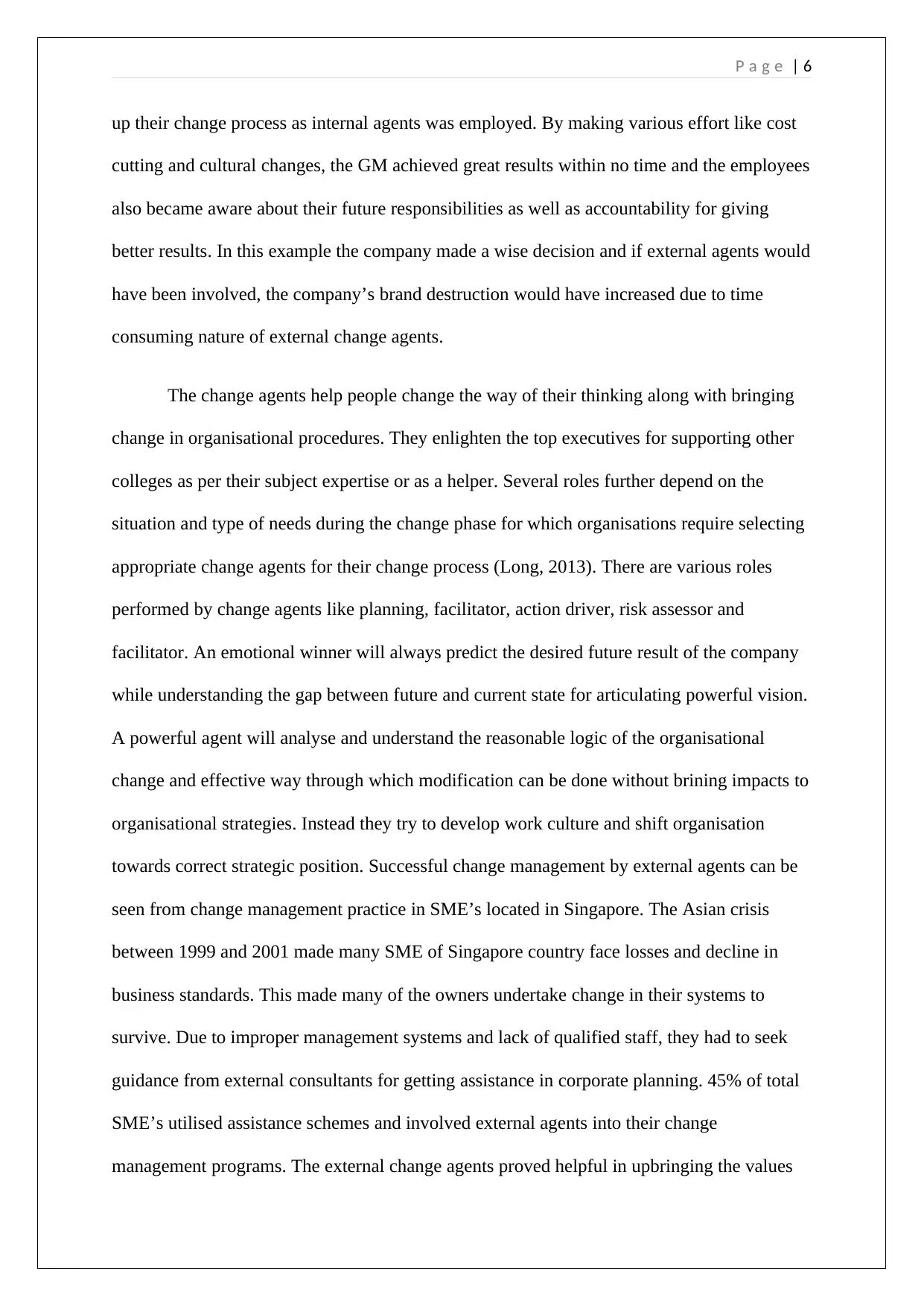
P a g e | 6
up their change process as internal agents was employed. By making various effort like cost
cutting and cultural changes, the GM achieved great results within no time and the employees
also became aware about their future responsibilities as well as accountability for giving
better results. In this example the company made a wise decision and if external agents would
have been involved, the company’s brand destruction would have increased due to time
consuming nature of external change agents.
The change agents help people change the way of their thinking along with bringing
change in organisational procedures. They enlighten the top executives for supporting other
colleges as per their subject expertise or as a helper. Several roles further depend on the
situation and type of needs during the change phase for which organisations require selecting
appropriate change agents for their change process (Long, 2013). There are various roles
performed by change agents like planning, facilitator, action driver, risk assessor and
facilitator. An emotional winner will always predict the desired future result of the company
while understanding the gap between future and current state for articulating powerful vision.
A powerful agent will analyse and understand the reasonable logic of the organisational
change and effective way through which modification can be done without brining impacts to
organisational strategies. Instead they try to develop work culture and shift organisation
towards correct strategic position. Successful change management by external agents can be
seen from change management practice in SME’s located in Singapore. The Asian crisis
between 1999 and 2001 made many SME of Singapore country face losses and decline in
business standards. This made many of the owners undertake change in their systems to
survive. Due to improper management systems and lack of qualified staff, they had to seek
guidance from external consultants for getting assistance in corporate planning. 45% of total
SME’s utilised assistance schemes and involved external agents into their change
management programs. The external change agents proved helpful in upbringing the values
up their change process as internal agents was employed. By making various effort like cost
cutting and cultural changes, the GM achieved great results within no time and the employees
also became aware about their future responsibilities as well as accountability for giving
better results. In this example the company made a wise decision and if external agents would
have been involved, the company’s brand destruction would have increased due to time
consuming nature of external change agents.
The change agents help people change the way of their thinking along with bringing
change in organisational procedures. They enlighten the top executives for supporting other
colleges as per their subject expertise or as a helper. Several roles further depend on the
situation and type of needs during the change phase for which organisations require selecting
appropriate change agents for their change process (Long, 2013). There are various roles
performed by change agents like planning, facilitator, action driver, risk assessor and
facilitator. An emotional winner will always predict the desired future result of the company
while understanding the gap between future and current state for articulating powerful vision.
A powerful agent will analyse and understand the reasonable logic of the organisational
change and effective way through which modification can be done without brining impacts to
organisational strategies. Instead they try to develop work culture and shift organisation
towards correct strategic position. Successful change management by external agents can be
seen from change management practice in SME’s located in Singapore. The Asian crisis
between 1999 and 2001 made many SME of Singapore country face losses and decline in
business standards. This made many of the owners undertake change in their systems to
survive. Due to improper management systems and lack of qualified staff, they had to seek
guidance from external consultants for getting assistance in corporate planning. 45% of total
SME’s utilised assistance schemes and involved external agents into their change
management programs. The external change agents proved helpful in upbringing the values
⊘ This is a preview!⊘
Do you want full access?
Subscribe today to unlock all pages.

Trusted by 1+ million students worldwide
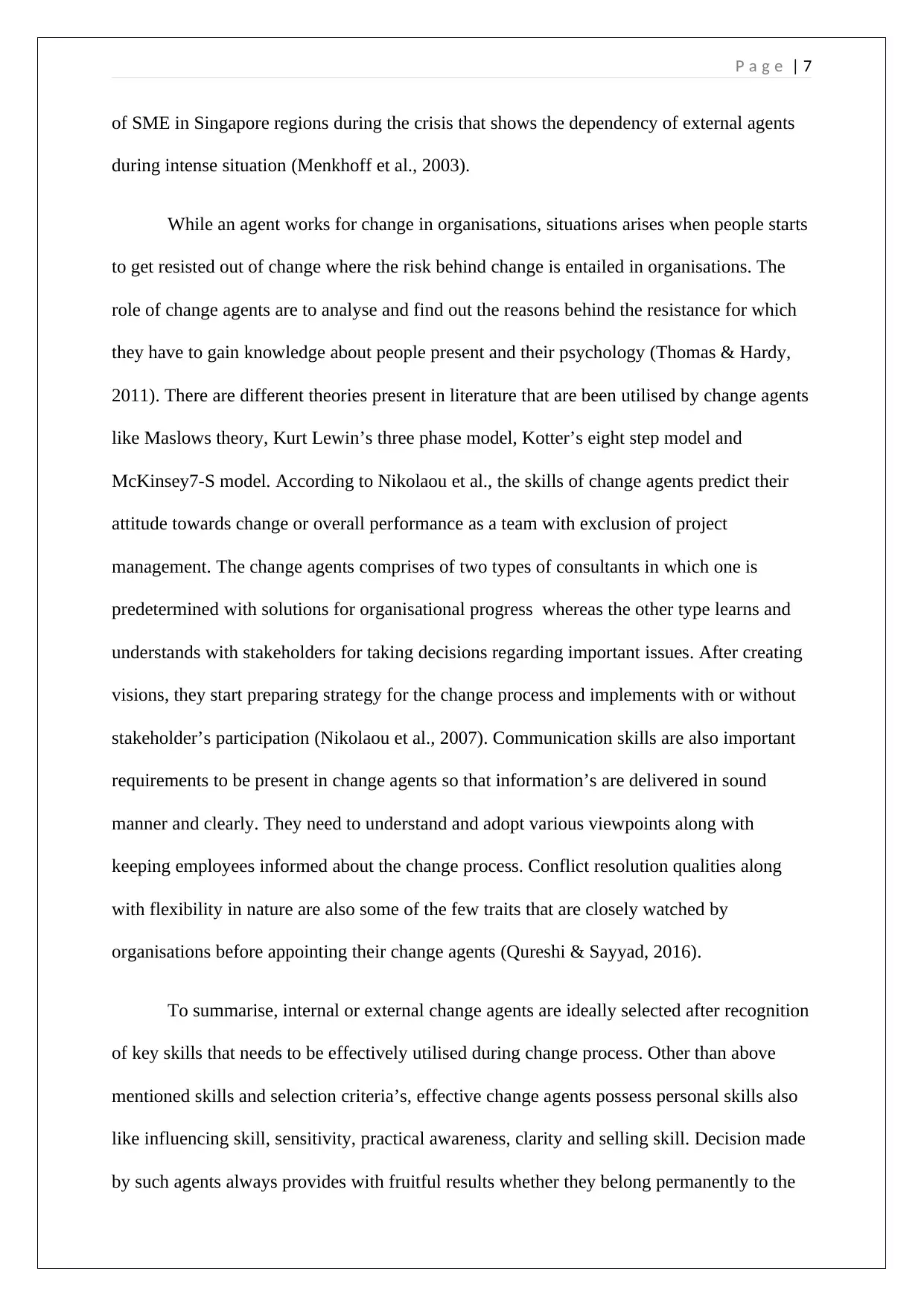
P a g e | 7
of SME in Singapore regions during the crisis that shows the dependency of external agents
during intense situation (Menkhoff et al., 2003).
While an agent works for change in organisations, situations arises when people starts
to get resisted out of change where the risk behind change is entailed in organisations. The
role of change agents are to analyse and find out the reasons behind the resistance for which
they have to gain knowledge about people present and their psychology (Thomas & Hardy,
2011). There are different theories present in literature that are been utilised by change agents
like Maslows theory, Kurt Lewin’s three phase model, Kotter’s eight step model and
McKinsey7-S model. According to Nikolaou et al., the skills of change agents predict their
attitude towards change or overall performance as a team with exclusion of project
management. The change agents comprises of two types of consultants in which one is
predetermined with solutions for organisational progress whereas the other type learns and
understands with stakeholders for taking decisions regarding important issues. After creating
visions, they start preparing strategy for the change process and implements with or without
stakeholder’s participation (Nikolaou et al., 2007). Communication skills are also important
requirements to be present in change agents so that information’s are delivered in sound
manner and clearly. They need to understand and adopt various viewpoints along with
keeping employees informed about the change process. Conflict resolution qualities along
with flexibility in nature are also some of the few traits that are closely watched by
organisations before appointing their change agents (Qureshi & Sayyad, 2016).
To summarise, internal or external change agents are ideally selected after recognition
of key skills that needs to be effectively utilised during change process. Other than above
mentioned skills and selection criteria’s, effective change agents possess personal skills also
like influencing skill, sensitivity, practical awareness, clarity and selling skill. Decision made
by such agents always provides with fruitful results whether they belong permanently to the
of SME in Singapore regions during the crisis that shows the dependency of external agents
during intense situation (Menkhoff et al., 2003).
While an agent works for change in organisations, situations arises when people starts
to get resisted out of change where the risk behind change is entailed in organisations. The
role of change agents are to analyse and find out the reasons behind the resistance for which
they have to gain knowledge about people present and their psychology (Thomas & Hardy,
2011). There are different theories present in literature that are been utilised by change agents
like Maslows theory, Kurt Lewin’s three phase model, Kotter’s eight step model and
McKinsey7-S model. According to Nikolaou et al., the skills of change agents predict their
attitude towards change or overall performance as a team with exclusion of project
management. The change agents comprises of two types of consultants in which one is
predetermined with solutions for organisational progress whereas the other type learns and
understands with stakeholders for taking decisions regarding important issues. After creating
visions, they start preparing strategy for the change process and implements with or without
stakeholder’s participation (Nikolaou et al., 2007). Communication skills are also important
requirements to be present in change agents so that information’s are delivered in sound
manner and clearly. They need to understand and adopt various viewpoints along with
keeping employees informed about the change process. Conflict resolution qualities along
with flexibility in nature are also some of the few traits that are closely watched by
organisations before appointing their change agents (Qureshi & Sayyad, 2016).
To summarise, internal or external change agents are ideally selected after recognition
of key skills that needs to be effectively utilised during change process. Other than above
mentioned skills and selection criteria’s, effective change agents possess personal skills also
like influencing skill, sensitivity, practical awareness, clarity and selling skill. Decision made
by such agents always provides with fruitful results whether they belong permanently to the
Paraphrase This Document
Need a fresh take? Get an instant paraphrase of this document with our AI Paraphraser
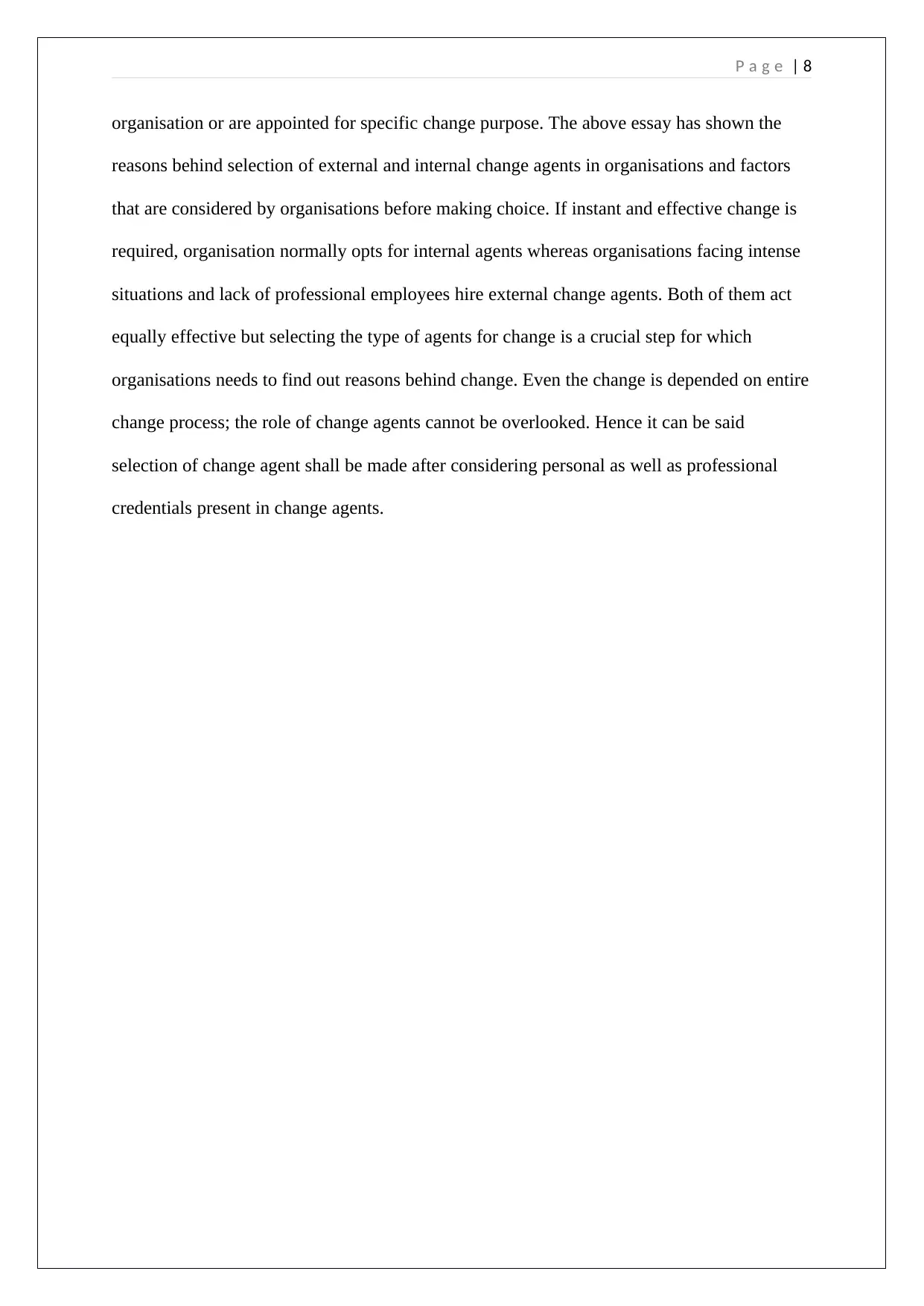
P a g e | 8
organisation or are appointed for specific change purpose. The above essay has shown the
reasons behind selection of external and internal change agents in organisations and factors
that are considered by organisations before making choice. If instant and effective change is
required, organisation normally opts for internal agents whereas organisations facing intense
situations and lack of professional employees hire external change agents. Both of them act
equally effective but selecting the type of agents for change is a crucial step for which
organisations needs to find out reasons behind change. Even the change is depended on entire
change process; the role of change agents cannot be overlooked. Hence it can be said
selection of change agent shall be made after considering personal as well as professional
credentials present in change agents.
organisation or are appointed for specific change purpose. The above essay has shown the
reasons behind selection of external and internal change agents in organisations and factors
that are considered by organisations before making choice. If instant and effective change is
required, organisation normally opts for internal agents whereas organisations facing intense
situations and lack of professional employees hire external change agents. Both of them act
equally effective but selecting the type of agents for change is a crucial step for which
organisations needs to find out reasons behind change. Even the change is depended on entire
change process; the role of change agents cannot be overlooked. Hence it can be said
selection of change agent shall be made after considering personal as well as professional
credentials present in change agents.
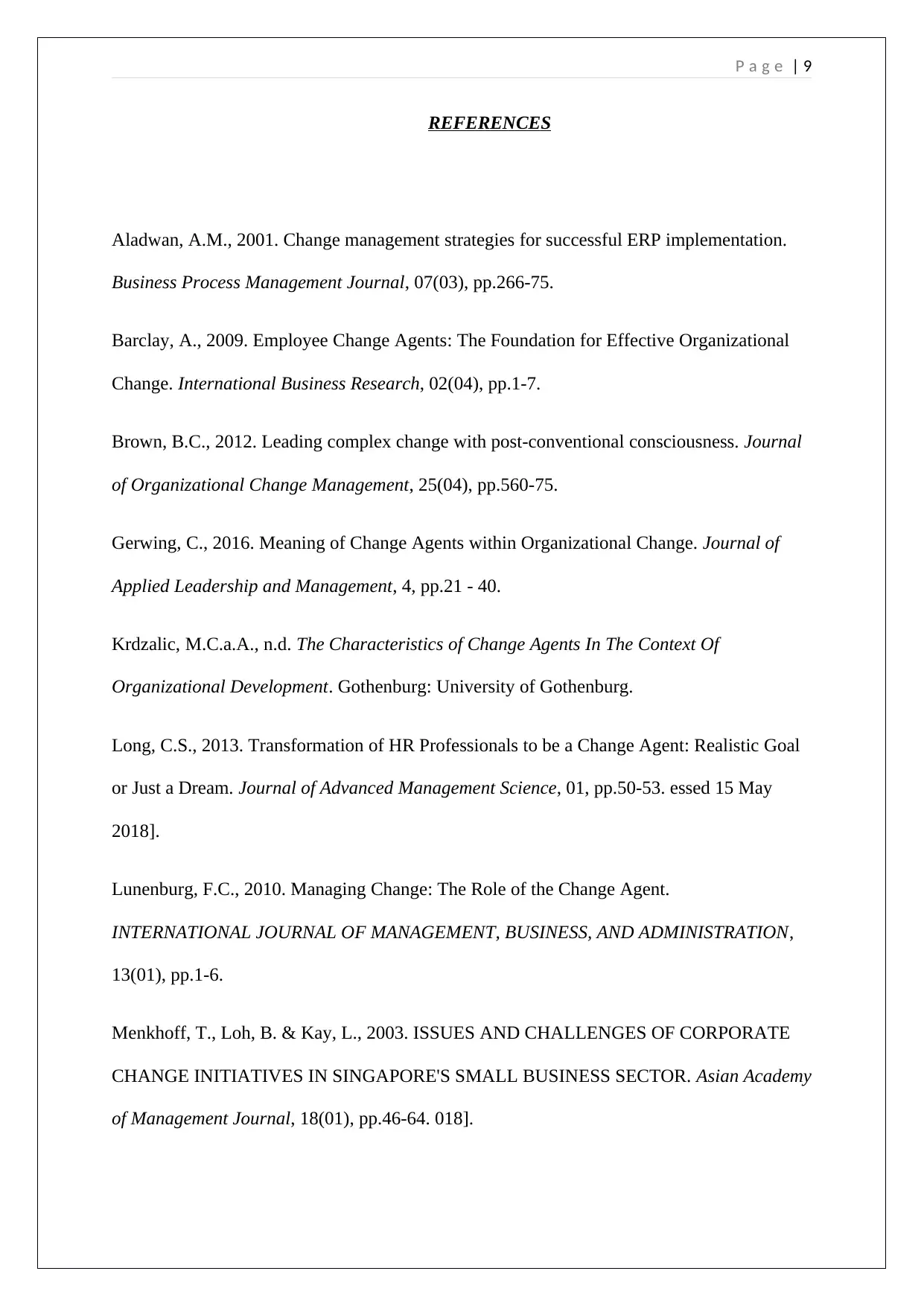
P a g e | 9
REFERENCES
Aladwan, A.M., 2001. Change management strategies for successful ERP implementation.
Business Process Management Journal, 07(03), pp.266-75.
Barclay, A., 2009. Employee Change Agents: The Foundation for Effective Organizational
Change. International Business Research, 02(04), pp.1-7.
Brown, B.C., 2012. Leading complex change with post-conventional consciousness. Journal
of Organizational Change Management, 25(04), pp.560-75.
Gerwing, C., 2016. Meaning of Change Agents within Organizational Change. Journal of
Applied Leadership and Management, 4, pp.21 - 40.
Krdzalic, M.C.a.A., n.d. The Characteristics of Change Agents In The Context Of
Organizational Development. Gothenburg: University of Gothenburg.
Long, C.S., 2013. Transformation of HR Professionals to be a Change Agent: Realistic Goal
or Just a Dream. Journal of Advanced Management Science, 01, pp.50-53. essed 15 May
2018].
Lunenburg, F.C., 2010. Managing Change: The Role of the Change Agent.
INTERNATIONAL JOURNAL OF MANAGEMENT, BUSINESS, AND ADMINISTRATION,
13(01), pp.1-6.
Menkhoff, T., Loh, B. & Kay, L., 2003. ISSUES AND CHALLENGES OF CORPORATE
CHANGE INITIATIVES IN SINGAPORE'S SMALL BUSINESS SECTOR. Asian Academy
of Management Journal, 18(01), pp.46-64. 018].
REFERENCES
Aladwan, A.M., 2001. Change management strategies for successful ERP implementation.
Business Process Management Journal, 07(03), pp.266-75.
Barclay, A., 2009. Employee Change Agents: The Foundation for Effective Organizational
Change. International Business Research, 02(04), pp.1-7.
Brown, B.C., 2012. Leading complex change with post-conventional consciousness. Journal
of Organizational Change Management, 25(04), pp.560-75.
Gerwing, C., 2016. Meaning of Change Agents within Organizational Change. Journal of
Applied Leadership and Management, 4, pp.21 - 40.
Krdzalic, M.C.a.A., n.d. The Characteristics of Change Agents In The Context Of
Organizational Development. Gothenburg: University of Gothenburg.
Long, C.S., 2013. Transformation of HR Professionals to be a Change Agent: Realistic Goal
or Just a Dream. Journal of Advanced Management Science, 01, pp.50-53. essed 15 May
2018].
Lunenburg, F.C., 2010. Managing Change: The Role of the Change Agent.
INTERNATIONAL JOURNAL OF MANAGEMENT, BUSINESS, AND ADMINISTRATION,
13(01), pp.1-6.
Menkhoff, T., Loh, B. & Kay, L., 2003. ISSUES AND CHALLENGES OF CORPORATE
CHANGE INITIATIVES IN SINGAPORE'S SMALL BUSINESS SECTOR. Asian Academy
of Management Journal, 18(01), pp.46-64. 018].
⊘ This is a preview!⊘
Do you want full access?
Subscribe today to unlock all pages.

Trusted by 1+ million students worldwide
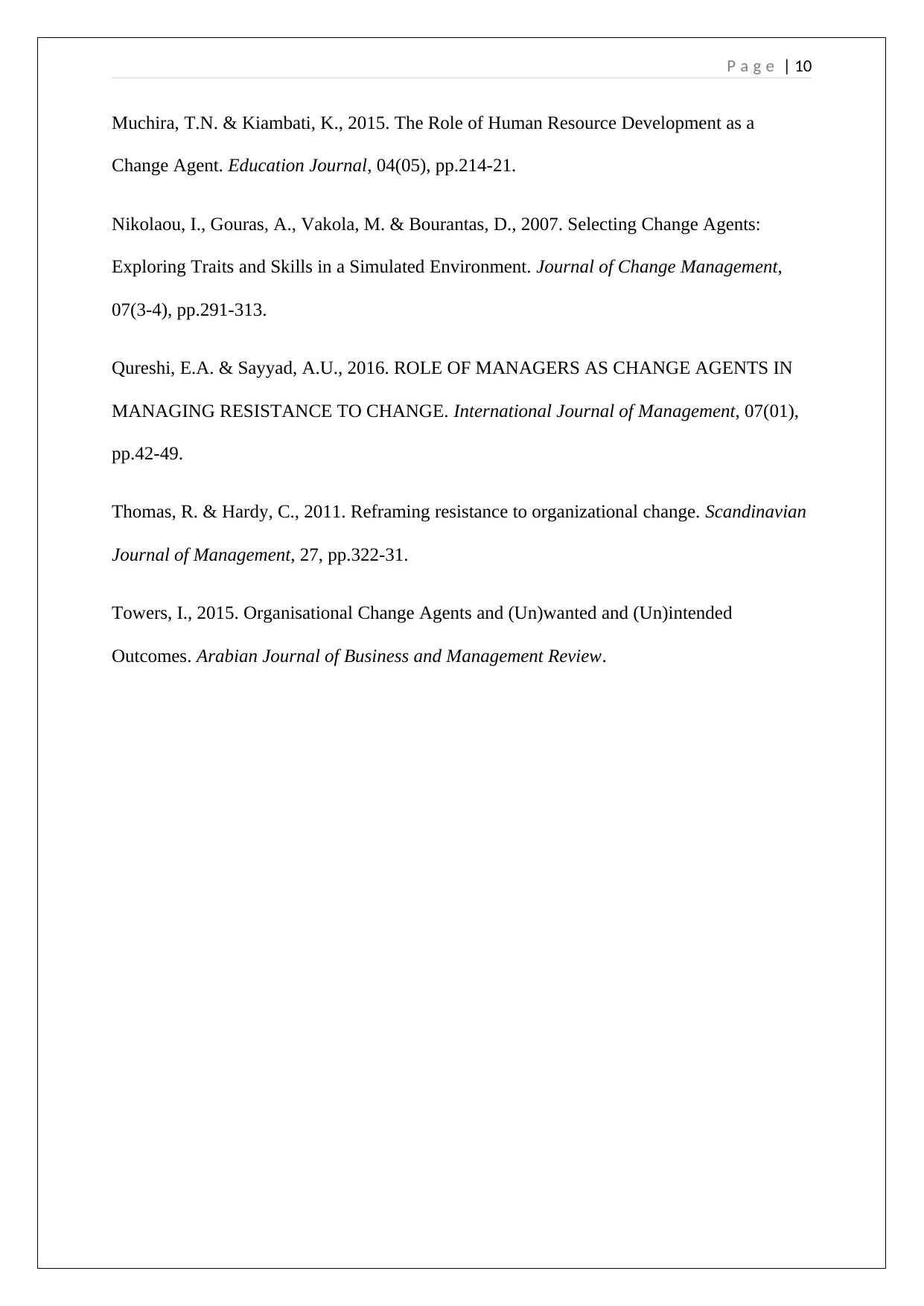
P a g e | 10
Muchira, T.N. & Kiambati, K., 2015. The Role of Human Resource Development as a
Change Agent. Education Journal, 04(05), pp.214-21.
Nikolaou, I., Gouras, A., Vakola, M. & Bourantas, D., 2007. Selecting Change Agents:
Exploring Traits and Skills in a Simulated Environment. Journal of Change Management,
07(3-4), pp.291-313.
Qureshi, E.A. & Sayyad, A.U., 2016. ROLE OF MANAGERS AS CHANGE AGENTS IN
MANAGING RESISTANCE TO CHANGE. International Journal of Management, 07(01),
pp.42-49.
Thomas, R. & Hardy, C., 2011. Reframing resistance to organizational change. Scandinavian
Journal of Management, 27, pp.322-31.
Towers, I., 2015. Organisational Change Agents and (Un)wanted and (Un)intended
Outcomes. Arabian Journal of Business and Management Review.
Muchira, T.N. & Kiambati, K., 2015. The Role of Human Resource Development as a
Change Agent. Education Journal, 04(05), pp.214-21.
Nikolaou, I., Gouras, A., Vakola, M. & Bourantas, D., 2007. Selecting Change Agents:
Exploring Traits and Skills in a Simulated Environment. Journal of Change Management,
07(3-4), pp.291-313.
Qureshi, E.A. & Sayyad, A.U., 2016. ROLE OF MANAGERS AS CHANGE AGENTS IN
MANAGING RESISTANCE TO CHANGE. International Journal of Management, 07(01),
pp.42-49.
Thomas, R. & Hardy, C., 2011. Reframing resistance to organizational change. Scandinavian
Journal of Management, 27, pp.322-31.
Towers, I., 2015. Organisational Change Agents and (Un)wanted and (Un)intended
Outcomes. Arabian Journal of Business and Management Review.
1 out of 10
Related Documents
Your All-in-One AI-Powered Toolkit for Academic Success.
+13062052269
info@desklib.com
Available 24*7 on WhatsApp / Email
![[object Object]](/_next/static/media/star-bottom.7253800d.svg)
Unlock your academic potential
Copyright © 2020–2025 A2Z Services. All Rights Reserved. Developed and managed by ZUCOL.





